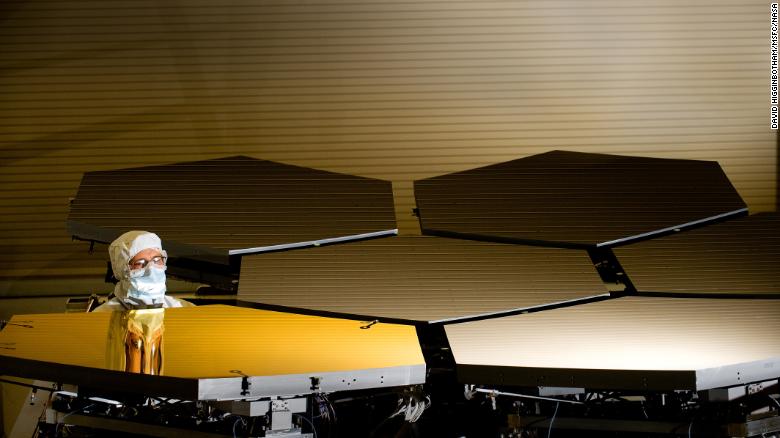This was the launch of the James Webb space telescope 1:06
(CNN) -
The most powerful space telescope ever built stays cool in space.
The James Webb Space Telescope, which launched on Christmas Day, successfully completed the deployment of its 21-meter parasol on Tuesday.
This critical milestone is one of several that must occur for NASA's observatory to function properly in space, and having achieved it was a great relief to Webb's team.
"Deploying Webb's parasol in space is an incredible watershed, crucial to the success of the mission," said Gregory L. Robinson, Webb's program director at NASA Headquarters, in a statement.
"Thousands of parts had to work with precision for this engineering marvel to fully unfold. The team has accomplished an audacious feat with the complexity of this implementation, one of the most audacious projects yet for Webb."
It's one of the most challenging spacecraft deployments NASA has ever attempted, according to the agency.
Unfolding a tennis court in space
The huge five-layer hood will protect Webb's giant mirror and instruments from the sun's heat.
Both the mirror and the instruments must be kept at a very cold temperature of negative 188 degrees Celsius to be able to observe the universe as it was designed.
Each of the five blades is as thin as a human hair and is coated with reflective metal.
advertising
When Webb launched, the hood was bent to fit inside the Ariane 5 rocket that carried the telescope into space.
The eight-day process to deploy and tighten the protective shield began on December 28.
This included deploying the shield support structure over the course of several days before tightening or adjusting of each layer could begin.
NASA to launch a new X-ray telescope designed to solve the mysteries of black holes
The fifth layer of the sun visor was adjusted and secured in place this Tuesday at 11:59 am ET.
Overall, the entire process, which was controlled by teams on Earth, included the perfect and coordinated movement of hundreds of release mechanisms, hinges, deployment motors, pulleys, and cables.
"The membrane tension phase of sunshade deployment is especially challenging because there are complex interactions between structures, tension mechanisms, cables and membranes," said James Cooper, director of Webb Sunshades at NASA. Goddard Space Flight Center, in a statement.
.
"This was the hardest part to test on the ground, so it feels amazing that everything went so well today."
The teams have been working 12-hour shifts to ensure that everything goes smoothly with the Webb deployments.
With the sunshade successfully in place, Webb project manager Bill Ochs said the telescope has exceeded the potential of 70% to 75% of the more than 300 single-point faults that could disrupt its ability to function.
This is what the Webb telescope's hood looks like once it is fully deployed.
The teams tested this difficult process on Earth a year before its launch.
"This milestone represents the pioneering spirit of thousands of engineers, scientists and technicians who spent a significant portion of their careers developing, designing, manufacturing and testing this first-of-its-kind space technology," said Jim Flynn, manager of sun protection at Northrop Grumman, NASA's Webb prime contractor, in a statement.
The telescope has the ability to look back in time, using its infrared observations to reveal otherwise invisible aspects and look deeper than ever into the universe.
The Webb Telescope will observe every phase of cosmic history, including the first flashes after the Big Bang that created our universe and the formation of the galaxies, stars, and planets that fill it today. Its capabilities will allow the observatory to look inside the atmospheres of exoplanets and investigate the faint signals from the first galaxies formed 13.5 billion years ago.
"This is the first time that anyone has tried to put a telescope of this size in space," said Thomas Zurbuchen, associate administrator for NASA's Science Mission Directorate, in a statement.
"Webb required not only careful assembly, but careful implementations as well. The success of its most challenging implementation, the parasol, is an incredible testament to the human ingenuity and engineering skill that will enable Webb to achieve its scientific goals."
NASA's Parker Solar Probe Becomes First Spacecraft to "Touch" the Sun
What comes next
Webb is expected to take about 29 days to reach its intended orbit one million miles from Earth, with other critical steps on the way, and that includes another big challenge later this week: unfolding the telescope's mirror.
The mirror can be extended 6.5 meters, an enormous length that will allow it to collect more light from objects once the telescope is in space.
The more light the mirror can catch, the more detail the telescope can see.
It is the largest mirror NASA has ever built, but its size created a unique problem.
The mirror was so large that it could not fit inside a rocket.
Engineers designed the telescope as a series of moving parts that can be folded origami-style and fit within a 5-meter space for launch.
Ball Aerospace Optical Technician Scott Murray inspects the first few segments of the gold primary mirror during assembly.
Here's the next series of crucial steps for Webb: making sure the mirror's 18 gold-plated hexagonal segments unfold and lock together.
All of these steps are expected to be completed by the end of this week.
Finally, Webb will make one more trajectory adjustment to insert himself into an orbit that goes beyond the moon.
While that completes the 29 days, the telescope will go through a commissioning period in space lasting about five and a half months, which involves cooling, aligning and calibrating its instruments.
All instruments will also go through a verification process to see how they are performing.
Webb will begin collecting data and its first images in late 2022, and they are expected to be released in June or July, forever changing the way we view and understand the universe.
SpaceNASATeloscope

